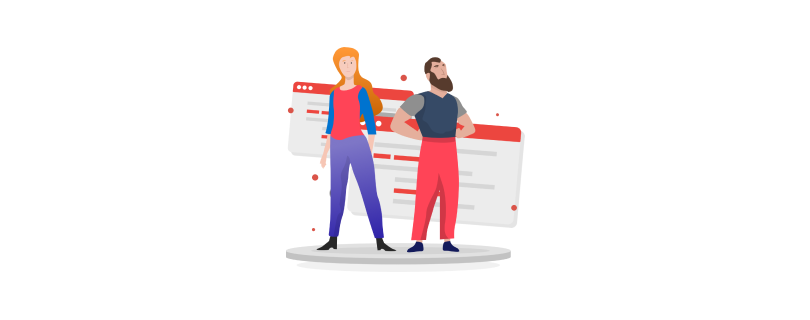
Working remotely – Simple guide for people who want to start but are afraid

Mr. Right
I want to tell you about working remotely. But before we break down the concept of remote work into smaller chunks, I’ll first lay out why I’m the right person to do this.
I’ve been working remotely for Scalac – a Scala development company – for two and a half years. This has given me enough time to experience all the pros and cons of working from home. This includes figuring out how to behave when a problem is escalating on the other side of the screen, how to manage formal and informal communication and keep my work-life balance healthy. After this time, I can tell you with certainty that it’s possible to connect with and efficiently motivate remote coworkers enough to keep a project up and running. However, for some, breaking free from strict corporate rules and meme-communication might be a challenge.
In my case, remote work was the natural result of my personal development process. I started to experiment with my work environment long before I was fetching project repos on my home network. For me, remote work has been an opportunity to discover the perfect workplace in the sense described below.
What working remotely really means
So, what exactly is remote work? Your first guess is probably you’d take laptop and stuff from the office and, instead of traveling through a city to your “9–5 building”, move through your living space to the area you’ve assigned to be your “home office.” I know that’s how working remotely might seem from the outside, but this point of view is totally wrong. It’s not just about changing your place of work. It also involves changing your mindset on both your personal and professional life. Communicating screen to screen is different; self-organization in the era of distractions is different; even your working hours and work-life balance might look different at home. As I mentioned before, I’d like to break it all down for you, step by step, and show you how working from home changes your perspective when it comes to:
- work ergonomics
- work-life balance
- self-organization
- communication
I would also like to emphasize that this guide is based on my own personal experience and discussions with coworkers. Working from home is a journey on which I have discovered what suits me best. What follows shouldn’t be treated as a set of rules, but rather as advice.
Work ergonomics
This might not be the most obvious aspect of working from home. You might remember the “perfect” work position, described in terms of angles for your legs, arms, neck, chair, and monitor to ensure the “correct” posture in front of the computer. I certainly don’t, but I do remember the pain in my neck and lower back caused by uncomfortable chairs and small desks ( which remain too small even after six months processing corporate paperwork for a replacement desk).
At home, you can place your monitor on the wall, have it standing, or use a holding arm to find a position that is comfortable for your neck. You can buy any chair you find comfortable (in my case, a relatively cheap chair from the furniture store was much more convenient than an expensive gaming chair). At the office, your employer takes care of the equipment, but at home, it’s up to you – this can be one of the biggest cons of building your own home office. On the other hand, it can also be one of the biggest pros, because you aren’t limited by health and safety regulations. You can buy the furniture and hardware that suits you best and personalize it as you wish. You don’t have to use 2×17″ monitors; you can use a 34″ one instead. You don’t have to stay sitting all day.
You can split up your workday by:
- sitting
- standing
- standing on a balance board
- half-lying on a sunbed
- lying down
- sitting on a gym ball
- or any other way you can think up

Pose!
Bear in mind that standing might be healthier than sitting, but it’s also more exhausting—meaning that you can lose focus after some time. The same with a balance board—it requires some practice, but once you get used to standing on the board, you can work and work out at the same time (after a few hours, it feels like taking a long walk). Lying down can be refreshing, and it might boost your creativity (for example, I often work 2–3 hours a day in the park lying on a lazy bag or hammock in the summertime).
One of the enormous benefits of working at home is the friendly, informal, and peaceful environment. Researchers at Cornell University point out that Even low-level office noise can increase health risks and lower task motivation for workers. The home environment also makes it more convenient to maintain healthy behavior between work sessions; for example, by exercising during breaks. Which leads us to the next subject.
Work-life balance
By this I mean:
- Keeping a healthy balance between time spent at work and time spent on other activities.
- Actively avoiding work burnout.
- Relaxing your mind after work and releasing work-related stress.
- Maintaining a healthy relationship with your body.
While many people are too shy to do even quick workouts at the office, home is a much nicer environment where you can do some sit-ups, deadlifts, pull-ups or stretch. Our bodies play an important role in our lives and keeping them healthy will positively influence your frame of mind as well as improve productivity and focus throughout the workday.
Working remotely saves you approximately 250 hours a year on commuting
Commuting
Another advantage of remote work is avoiding all the disadvantages that relate to commuting. In the USA, the Average Commute to Work time is around 1h (in Poland, where I live, it’s around 1.3h). That’s a lot of time that you can spend in better ways. It’s literally like leaving work an hour (or more) earlier. It’s an extra hour that you can use for your favorite activities or for spending time with your family. That’s 5 hours a week, about 21 hours a month and 250 hours a year! Not to mention your whole life.
The point is, you can manage your time better because if you don’t have to leave your home; you have more time as well as the space to be yourself.
I usually do 5-minute workouts during every break and meditate for 10 minutes every 4 hours. It helps me to stay fresh and focused during the whole day. It also boosts my ability to focus on problems rather than worry about expectations. Breaks are beneficial ( New Study Shows Correlation Between Employee Engagement And The Long-Lost Lunch Break) and it’s vital that you use them mindfully!
Working 9 to 5?
Working at home might be better, but it can also be a nightmare when it comes to your work-life scheduling. Does that sound confusing and scary? Let me explain! At home, you don’t have to stick to traditional 9–5 work hours. You can book calls with coworkers and clients at more convenient times and fit-in your responsibilities at the times that suit you best.
Furthermore, it means you can be more flexible when working with people in different timezones. However, it also means that if you’re not assertive, you can end up working at times that don’t suit you.
Consider trying out some different workday schedules:
- Fitting most of your work into the first half of the day.
- Fitting most of your work into the second half of the day (usually with some calls in the morning).
- Breaking up your work throughout the day.
You should choose the schedule that fits your biorhythm and situation best. However, if you have a tendency to work too hard, it’s very likely that you’re going to try to use all three schedules at once—i.e. work the whole day. Because no one is watching you, there can be a considerable temptation to finish your work by doing overtime… Don’t. Tasks often take more than one day, and it’s easy to underestimate how long any given task will take. You should communicate that you need more time to finish the task to your manager or team leader. Doing overtime is a straightforward recipe for a quick burn-out and draining of your natural enthusiasm for work.
Advanced scheduling
While it’s quite easy to schedule your working hours for either the first or second half of the day, I’ll explain how to approach scheduling a fragmented workday. Imagine you have some free time in the morning you can spend on working, but then you have to take your children to school, then you visit the nearest coffee shop because you need to have a meeting, you also work there for some time before getting back home and finishing up your workday. You can cross over your work with daily tasks and still get everything done; you might discover that this can be extremely beneficial. That said, I would recommend a fragmented work schedule for more experienced remote workers who have excellent time organization skills, as it’s easy to work too much or too little if you fail to plan it carefully.
Other techniques to help you draw a thicker dividing line between work and private life are:
- Choosing a dedicated place in your home/room to work in. Somewhere you set the rules and won’t be interrupted.
- Having a distinctive uniform just for work. It might be smart casual or some pajamas, but make sure it’s something you wear only while working.
- Turning off notifications. Some people are not bothered by notifications. Others require quality time without ‘work noise.’
Self-organization
Let’s be honest, the modern world has too many distractions. Workers must often really try hard to stay focused. Don’t blame people. It’s hard to keep a clear mind when you’re surrounded by media specifically engineered to grab your attention. It’s even harder at home because you don’t have coworkers who would give you dirty looks if they noticed you spending the whole day scrolling through news feeds.
How to deal with distractions?
- You might have noticed that I’ve mentioned this before: breaks! Adequate breaks are crucial for maintaining your mental capacity and staying focused. It might be a “tea break” every hour or quick breaks using the Pomodoro technique (which I use to refill my water tank and exercise). You should try out whatever you find works for you.
- To-do lists. Knowing your plans makes them easier to follow. Remember to keep them simple and don’t waste too much time writing to-dos. I use a very minimalistic to-do app. You can do the same or use a more nuanced one, or don’t use an app at all – just describe your plan briefly in notepad.
- Workflow apps. If you have a lot of responsibilities, it can be very beneficial to use apps for long term planning. You can use Gantt chart apps, agile apps, or even mind maps. Whatever suits you best.
- Website blockers. There are a few apps that can block distracting websites and apps on a specified schedule. If you have a hard time restraining yourself from checking your favorite meme site every 5 minutes, maybe you should give one a try.
- Time trackers. Plugins such as coding time trackers might give shocking results at first—in the programming world, not all of your time is spent coding (there are meetings, the creative aspects, the conceptual aspects, etc.). Time trackers will help you identify your productivity cycles and help to figure out how your work can fit in perfectly with your schedule.
- Well-implemented agile is a great tool for time and task organization for teams. An essential part of the agile process is to discuss tasks. This will help you organize time and help you build a representation of the task in your mind, generating ideas for solutions.
- Focus on solutions, not tools. This can be a dead-end for a lot of young apprentices. Tools are meant to solve problems; if they’re becoming an obstacle they should be changed or improved or even thrown away.
- And, finally, to be well organized you should communicate with your teammates. Clear, polite and constructive communication is the key.

Communication
This is an element of remote work – actually I would say any work – that needs a lot of your attention. Because interactions are not forced upon you by office conventions, they require a more proactive approach. You might find it surprising, but remote workers have to communicate! No, you can’t sit in your basement without talking to people for months. Sorry for spoiling that for you. With good leadership, good communication can result in better relationships, where interactions are more meaningful and involve an exchange of useful feedback.
It’s easier when you work remotely
- It is easier to schedule appointments working remotely.
- When you’re not at the office you don’t waste time to find and book a conference room.
- It is troublesome to interrupt someone speaking remotely.
- It’s super convenient to use the messaging app and, because all messages are saved as text, sometimes this lets you skip overplanned meetings (and make no mistake, IT developers hate overplanned meetings).
- It is also more convenient to pair program on other workstations, sharing your IDE session instead of a keyboard.
…but it’s not hassle-free
It all sounds incredible, doesn’t it? Of course! But there’s a dark side as well. Even though it’s mainly a stereotype, some IT workers, just like any other, can be somewhat specific individuals, who don’t have a strong desire to communicate. Proactivity is crucial for keeping workers “alive” in a company network. No one will see your face or detect your mood. Remotely, your presence will be limited, so it’s super important to verbalize your needs and worries.
You might ask:
- How will your team lead/manager know you’re struggling with a task?
- How will anyone know that you’ve taken on too much work and need help?
- How can you improve your project when you are frustrated with it but haven’t told anyone?
- What should you do after finishing your current task?
- What’s in your boss’s mind?
These are the kinds of questions that a remote worker must take into consideration and communicate. On a personal level, this requires practice, proactivity, and goodwill; on the company level, this involves strategy. At Scalac, we use different kinds of remote and in-person activities to engage employees. Mentoring programs to help newcomers with remote work, and special programs for exchanging feedback and to encourage coworkers to give constructive feedback.
Finally, I want you to remember that different people have different social sensitivities and needs. Some employees might be much more productive and communicative when doing all their communication remotely. Others require real-time interactions with varying frequencies to maintain their enthusiasm for the company’s mission. And both ways are okay.
Summary
In my opinion, remote work is a great way to improve team spirit. It’s also a great life-choice when approached in the right way. Traditional office work hours fail to use employees’ productivity optimally and are often detrimental to their health and work-life balance. Remote work is an opportunity that can be beneficial for many people in different sectors. In my experience, it naturally boosts my excitement about the challenges posed by work. As Confucius said: “Choose a job you love, and you will never have to work a day in your life“. A work environment that you can shape to your needs is a powerful tool for maintaining this attitude throughout your entire life.
Read also
Scale fast with Scalac – Scala development company ready to solve all your challenges.











